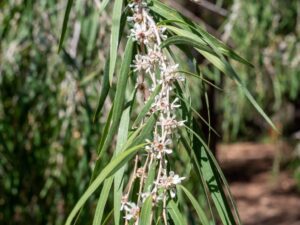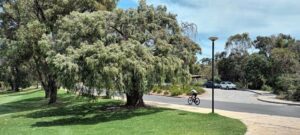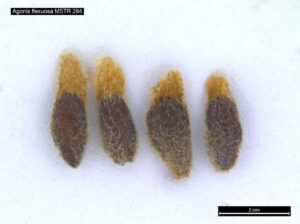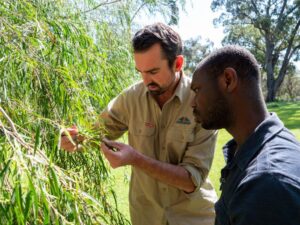
Seed collections help safeguard the future
By Matthew Stray
While Agonis flexuosa may appear robust and resilient, this long-lived species should not be taken for granted, nor should access to its seed. Threats to A. flexuosa exist through the processes of climate change as well as a potential incursion of Myrtle Rust into south west Western Australia.
Without doubt, Agonis flexuosa, or Peppermint Tree, is one of Western Australia’s most recognisable tree species. Adored by many for its weeping, decorative habit, showy white flowers and peppermint-scented leaves, its use as a versatile landscape and amenity tree within streetscapes, parks and reserves has endured for many years. An excellent shade tree, attracting pollinators and providing nesting opportunities for birds, A. flexuosa’s tolerance to alkaline soils also makes it a sound choice for coastal properties and larger home gardens across much of southern WA.
In the wild, A. flexuosa forms a keystone mid-story species within tuart forests and is the dominant canopy species across vast swaths of limestone heath and dune ecosystems throughout the State’s south west. The species, which occurs naturally in Botanic Gardens and Parks Authority (BGPA) managed Bold Park, delivers important ecological benefits, providing food, habitat and protection for fauna, including the vulnerable Western Ringtail Possum (Pseudocheirus occidentalis). It also holds cultural significance to the Noongar people who traditionally used the plant’s leaves as an antiseptic, and sapling trunks as spear shafts and digging sticks.

Myrtle Rust (Austropuccinia psidii) is recognised as one of the most significant emerging threats to ecosystem function and biodiversity in Western Australia. First detected in New South Wales on A. flexuosa ‘Afterdark’, A. flexuosa is considered highly susceptible. Repeated Myrtle Rust infections in some species can result in defoliation and mortality of mature plants, while infection of flowers, fruit and seedlings impacts recruitment. It is unclear just how great the impact of Myrtle Rust could be on wild populations of A. flexuosa, or even how favourable parts of WA’s south west will be in harbouring this potentially devastating plant pathogen. However, the risk is great and if Myrtle Rust were to establish and take hold on keystone species such as A. flexuosa, entire ecosystems could fall into decline.

During 2021, BGPA Manager Living Collections Amanda Shade and I spent time interrogating existing seed collections of A. flexuosa held at Kings Park to ensure Kings Park was in the strongest position possible to help safeguard this significant species. Reserves in the seed bank were determined to be quite low, with limited information available as to where some of the older seed had been sourced. Given the biosecurity threats looming over the State it was apparent efforts should be directed towards expanding Kings Park’s collections of A. flexuosa. As part of BGPA’s ongoing commitment to Mrytle Rust preparedness, a collecting program was developed dedicated to building on A. flexuosa provenance collections across the species’ natural range.

In January and February 2023, Kings Park’s Seed Centre conducted two collecting trips to the south west, spending 17 days in the field. The trips focused primarily on seed collections of A. flexuosa as well as other Myrtaceous species from a variety of ecosystems, and stretched between Bunbury, the most northerly collection location, to Gordon Inlet within Fitzgerald River National Park, recognised as the species’ most easterly natural occurrence. In total, 28 collections of A. flexuosa were made with the seed brought back to Kings Park where it was cleaned, processed and tested for viability before being stored in Kings Park’s Seed Bank. Once safely secure in the seed bank it is by no means a case of ‘set and forget’. Having such a large number of recent, well documented collections of a keystone species offers enormous potential for further research projects.

As luck would have it, the timing of these A. flexuosa collections lined up perfectly for Eric Asare, a PhD student at Edith Cowan University who is investigating the potential impact of Myrtle Rust on WA’s native flora. Fortunately, Eric was able to adapt his project to include trials on A. flexuosa. Now underway, the initial stage of his project will look to uncover variations in genetic diversity across natural populations within varying ecosystem types. Eric will be granted access to seed from a selection of Kings Park’s recent A. flexuosa collections to grow plants for genetic diversity sequencing studies. Any findings will be useful, as despite the high levels of morphological variation in A. flexuosa (ranging from compact shrubs to large trees) very little is known about genetic variation within this common species. Plants from populations considered to have the greatest genetic diversity will go on to be screened for their susceptibility to Myrtle Rust. This part of Eric’s project will be undertaken in Brisbane at the Queensland Department of Agriculture and Fisheries which will avoid any potential of introducing Myrtle Rust into Western Australia. It is anticipated that plants will be inoculated with Myrtle Rust in a glasshouse environment with symptoms and progression of the disease, including overall health of the plants, monitored over several weeks.
Identification of any Myrtle Rust resistant individuals will hopefully assist in determining the most suitable populations of A. flexuosa to target for future collection and breeding programs, with the goal to reduce the impact of Myrtle Rust if or when it arrives in the south west of WA.
It would be a great shame to see trees like A. flexuosa disappear from the landscape. Long may we enjoy and value the important role they play within our forests and coastal ecosystems, and contribute to our open spaces, streetscapes and home gardens.
Matthew Stray
Curator
WA Seed Centre Kings Park
Botanic Gardens and Parks Authority
